Lochnan, Peter William (Flying Officer)
Killed in Action 1941-May-21


Birth Date: 1914
Born:
Parents: Son of Frederick Michael and Lilian Mary Lochnan; husband of Jane Lochnan, of Toronto, Ontario.
Spouse: Husband of Jane Lochnan, of Toronto, Ontario.
Home: Ottawa, Ontario
Enlistment:
Enlistment Date: unkown date
Service
RCAF
Unit
400 Sqn- Squadron
Percussuri Vigiles On the watch to strike
Base
Rank
Flying Officer
Position
Pilot
Service Numbers
C/997
Home
Lysander serial: V9361
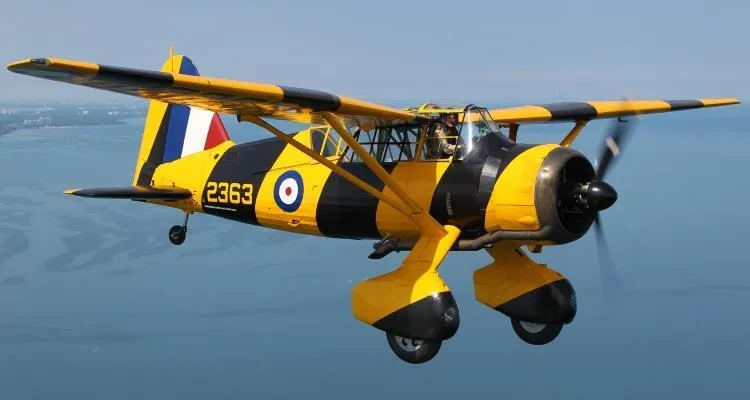
Canadian Warplane Heritage Museum
Westland Aircraft of Yeovil, UK, started to design an Army Cooperation aircraft for the British Air Ministry, in June 1935. The first Lysander flew a year later and demonstrated a remarkable short field performance that today would be seen in a STOL aircraft. At the outbreak of war in September 1939, seven RAF squadrons equipped with Lysanders were sent to France in support of the British Army. In May-June 1940, 118 Lysanders were destroyed in action and 120 aircrew were killed or taken prisoner. These severe losses showed that the old ideas about army support aircraft were out of date and the future lay in fighters like the Hurricane.
The most daring use of Lysanders in WW II was with the Special Operations Executive, which supported the Resistance in German occupied France and Belgium, by flying in agents and picking up escapees. It was during these night operations, that the Lysander came into its own, using its remarkable STOL capabilities to fly into the small fields marked out by the Resistance.
The first Canadian built Lysanders rolled out of National Steel Car factory at Malton, Ontario in September 1939 and later were delivered to RCAF No. 110 (Army Co-operation) Squadron at Rockcliffe, Ontario. In February 1940, No. 110 became the first RCAF squadron to be ordered overseas to Britain, becoming No. 400 Sqn..
By late 1941, most Canadian built Lysanders had been transferred to the British Commonwealth Air Training Plan (BCATP), where they were used for target towing at gunnery training schools. National Steel Car, which became Victory Aircraft, stopped building Lysanders in September 1942, as it started to gear up to manufacture Lancaster bombers. 1,652 Lysanders were built between 1938 and 1943; 225 of them in Canada. Lysanders served with the RAF, RCAF and the RAAF, as well as the air forces of seven other nations. Canadian Warplane Heritage Museum
Unit Desciption
400 Sqn Percussuri Vigiles ("City of Toronto")
History of the Squadron before and during World War II (Aircraft:Lysander III, Tomahawk I, IIA, IIB, Mustang I, Mosquito PR Mk. XVI, Spitfire PR Mk. XII)
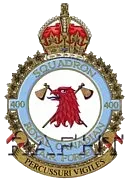
The squadron started life as No. 10 (Army Co-Operation) Squadron (Auxiliary) at Toronto in October 1932. In November 1937 the unit was renumbered No 110. On the outbreak of WWII, the squadron was mobilized and moved to Rockcliffe, ON, to train on Westland Lysander aircraft, having previously flown de Havilland DH-60 Moth, Fleet Fawn, Avro 621 Tutor, Avro 626, and de Havilland DH-82 Tiger Moth. The squadron arrived in England in February 1940. The squadron did not see action and with the fall of France, it remained in England, and was later renumbered as No. 400 (Army Cooperation) Squadron at Odiham, Hampshire, UK ![]() on March 1, 1941.
on March 1, 1941.
From then until 3 December 1942 the squadron was affiliated to No. 39 (Army Co-operation) Wing (RCAF), then it moved to Fighter Command (No 10 Group) at Dunsfold, Surrey. In December 1942 and January 1943 a section of aircraft flew in No 19 Group of Coastal Command providing fighter cover over the Bay of Biscay from airfields at Portreath and Trebelzue, Cornwall. The squadron rejoined 10 Group and then rapidly returned in January 1943 to No 39 Army Co-operation Wing, by now designated as a Fighter Reconnaissance (FR) Squadron. It then formed part of the 2nd Tactical Air Force, based successively at Woodchurch, Kent, Redhill, Surrey and Odiham, Hampshire. With squadron code letters SP, the squadron flew Curtiss Tomahawks, North American Mustangs and Supermarine Spitfires on photo-reconnaissance work, collecting intelligence information to help to plan the D-Day invasion, and later on the effects of bombing of V-1 launch sites. From December 1943 to May 1944 the squadron aircraft included 6 Mosquito PR Mk XVI. Shortly after D-day the Squadron moved to airfields in France, and provided tactical photographic reconnaissance for the British Second Army. As the armies moved forwards, the squadron followed, flying from bases in France, Belgium, The Netherlands and Germany. The squadron was finally disbanded at Luneburg, Germany ![]() in August 1945.
in August 1945.
In the course of the war, the squadron flew around 3000 sorties, for the loss of 12 pilots killed or missing. They destroyed numbers of enemy aircraft and attacked numerous trains and locomotives. They were awarded 10 DFC's, 1 Bar to DFC, 1 BEM, 3 MiD's. Battle Honours include Fortress Europe 1941–44, Dieppe, France and Germany 1944–45, Normandy 1944, Arnhem, Rhine, Biscay 1942–43 Kostenuk and Griffin
Maps for Movements of 400 Squadron 1940-45
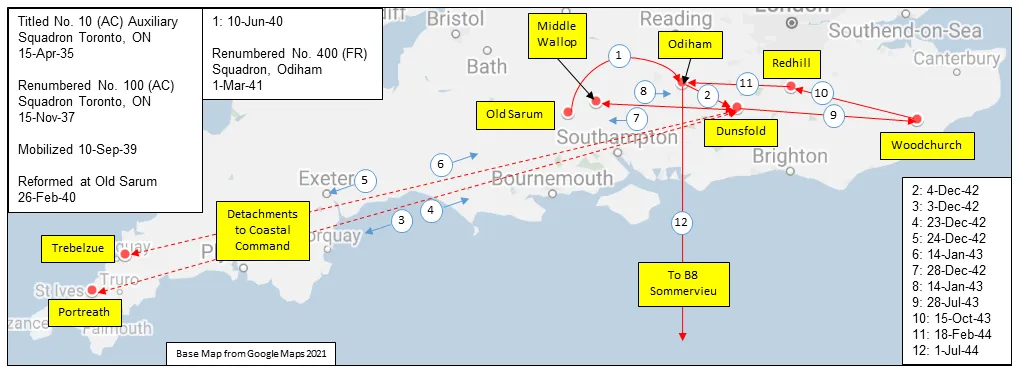
MAP 1: 400 Squadron Movements in Britain 1940-44, (right-click on image to display enlarged in new tab)
|
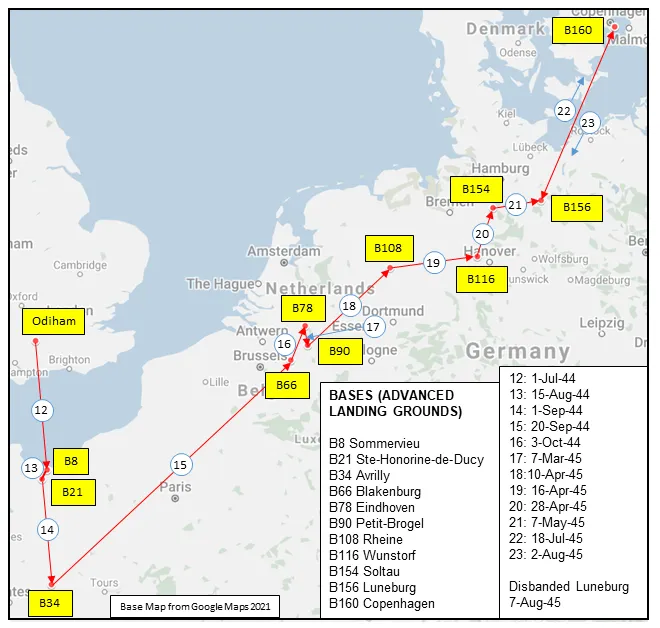
MAP 2: 400 Squadron Movements in Europe 1944-45
|
400 Sqn History Summary 1939-45
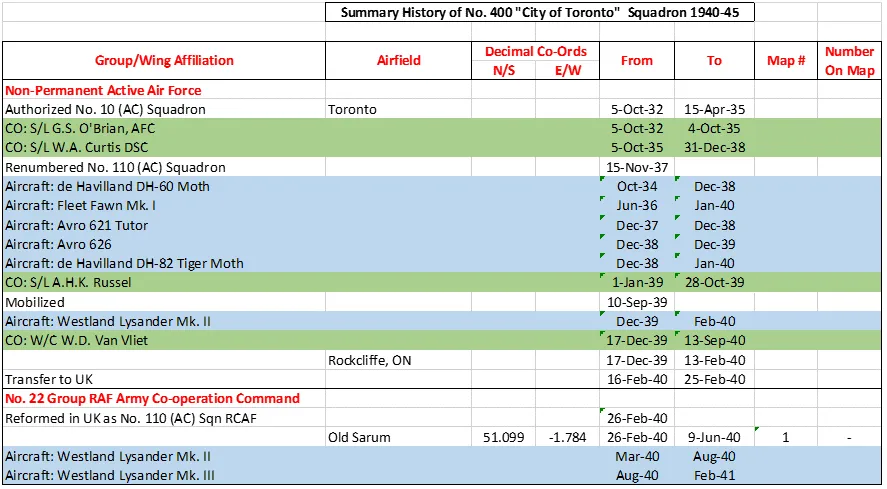
400 Sqn History Summary 1939-45 Page 2
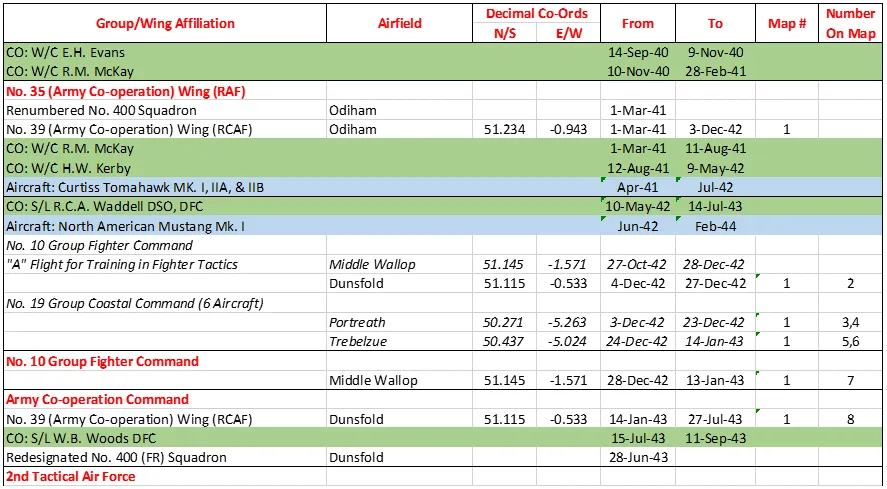
400 Sqn History Summary 1939-45 Page 3

History of the Squadron Post-WWII (Aircraft: Harvard III, Vampire III, Sabre V, Expeditor, Otter, Kiowa, Griffin)
No. 400 Squadron reformed at RCAF Station Downsview, ONtario ![]() on 15 April 1946 as an Auxiliary Fighter-Bomber Squadron, and later as an Auxiliary Fighter Squadron, operating North American Harvard Mk IIB. At the start of the Cold War the squadron flew de Havilland Vampire Mk IIIs and then Canadair Sabre Mk.V aircraft. It was re-named No. 400 "City of Toronto" (Fighter) Squadron on 6 November 1952, and then re-designated No. 400 “City of Toronto†Sqn (Aux) on 1 October 1958, when it was reassigned to a light transport and emergency rescue function and was equipped with Beechcraft Expeditor (1958) and de Havilland Otter (1960) aircraft. These aircraft were flown throughout the 1960s and 1970s.
on 15 April 1946 as an Auxiliary Fighter-Bomber Squadron, and later as an Auxiliary Fighter Squadron, operating North American Harvard Mk IIB. At the start of the Cold War the squadron flew de Havilland Vampire Mk IIIs and then Canadair Sabre Mk.V aircraft. It was re-named No. 400 "City of Toronto" (Fighter) Squadron on 6 November 1952, and then re-designated No. 400 “City of Toronto†Sqn (Aux) on 1 October 1958, when it was reassigned to a light transport and emergency rescue function and was equipped with Beechcraft Expeditor (1958) and de Havilland Otter (1960) aircraft. These aircraft were flown throughout the 1960s and 1970s.
Unification of the Canadian Forces brought about another name change, this time to 400 "City of Toronto" Air Reserve Squadron on 1 February 1968. In 1980, the conversion to helicopters began with the CH-136 Kiowa. The squadron received its current name in the 1980s, becoming 400 Tactical Helicopter and Training Squadron. The squadron moved to CFB Borden, Ontario ![]() in 1996 after the closure of CFB Downsview, and is now equipped with the CH-146 Griffon.
in 1996 after the closure of CFB Downsview, and is now equipped with the CH-146 Griffon.
During peacetime, the squadron fulfills 1 Wing commitments by providing operational and training support to the 4th Canadian Division, the defence of Canadian sovereignty, support to national taskings, and support to peacekeeping operations. Its secondary duties are to support search and rescue operations of the Royal Canadian Air Force.